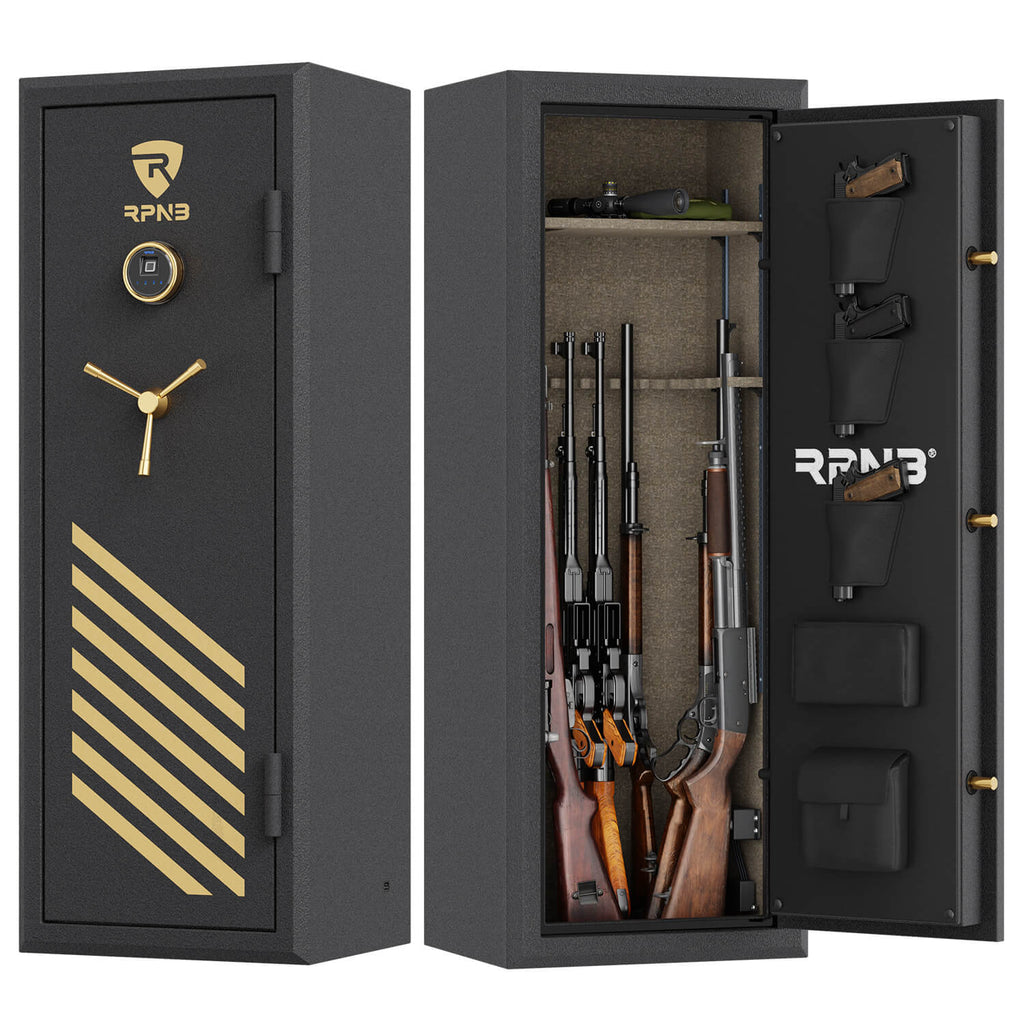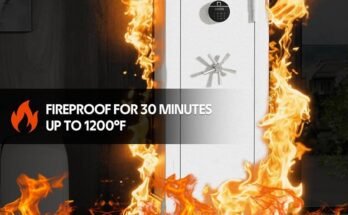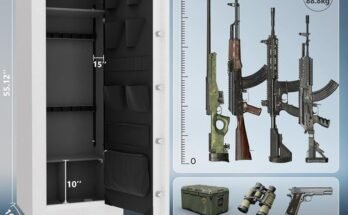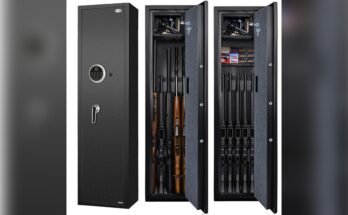You’ve invested in a biometric rifle safe to keep your firearms secure and easily accessible. But what happens if there’s a fire?
Can your safe truly protect your weapons and important documents from extreme heat and flames? If you’re wondering whether biometric rifle safes are fireproof, you’re not alone. Understanding the fire resistance of your safe could save you from costly damage or loss.
Keep reading to find out what you need to know to protect your valuables when it matters most.

Biometric Rifle Safes Basics
Biometric rifle safes use fingerprint technology to secure firearms. They offer quick access without keys or codes. This technology adds a layer of security that traditional locks cannot provide.
Understanding how biometric locks work and the types available helps in choosing the right safe. This knowledge is important for firearm owners who want both safety and convenience.
How Biometric Locks Work
Biometric locks scan and recognize fingerprints. The safe opens only when it detects an authorized print. This process is fast and usually takes less than a second.
The lock stores multiple fingerprints to allow access for trusted users. It uses sensors to read the ridges and patterns on the finger. This makes it hard for anyone else to open the safe.
Types Of Biometric Safes
There are several types of biometric safes based on size and features. Small safes hold handguns and small rifles. Larger safes can store multiple rifles and other valuables.
Some biometric safes include backup keys or digital codes. Others focus purely on fingerprint access. Fireproof models also exist but vary in protection level.
Fire Resistance Features
Fire resistance is an important feature in biometric rifle safes. It protects your firearms and valuables from fire damage. Not all biometric safes are fireproof. Some offer basic protection, while others have strong fire resistance.
Understanding the fire resistance features helps you choose the right safe. It ensures your guns stay secure during a fire emergency.
Materials Used In Fireproof Safes
Fireproof safes use special materials to block heat. Thick steel walls provide strong outer protection. Inside, fire-resistant insulation slows heat from reaching the contents.
Some safes have concrete or gypsum layers. These materials absorb heat and protect the interior. The door seals tightly to keep smoke and heat out. This design prevents damage to your firearms.
Fire Ratings Explained
Fire ratings show how long a safe can resist fire. Ratings are measured in minutes, such as 30, 60, or 90 minutes. The higher the rating, the longer the safe protects your items.
Tests use high temperatures, often above 1700°F (927°C). The safe must keep inside temperatures below 350°F (177°C). This is the limit to protect gunpowder and electronics inside.
Check the fire rating before buying a biometric rifle safe. It ensures you get the protection you need.
Fireproof Capabilities Of Biometric Safes
Biometric rifle safes offer quick access using fingerprint technology. Many users want to know about their fireproof capabilities. Fire protection is a key feature for anyone storing valuable firearms. Biometric safes often combine security with fire resistance to protect guns and important documents.
Fireproof capabilities depend on the safe’s design and materials. Many biometric safes come with fire ratings that show how long they can withstand heat. This rating helps buyers choose a safe that fits their needs. A fireproof safe can protect contents from high temperatures and smoke damage.
Common Fireproof Models
Several biometric rifle safes come with fireproof features. Brands like GunVault, Vaultek, and SentrySafe offer models with fire resistance. These safes often have ratings like 30 minutes at 1400°F or 1 hour at 1200°F. Such ratings mean the safe can protect guns during short fires.
Many models use fire-resistant insulation inside thick steel walls. The insulation slows heat transfer, keeping the inside cooler. Some safes also seal tightly to block smoke and water. These features help protect guns and paperwork inside the safe.
Limitations And Risks
Fireproof biometric safes are not fireproof forever. Most have limits on time and temperature they can handle. A very intense or long-lasting fire may damage the safe and its contents. Batteries powering biometric locks can fail during a fire.
Also, safes may protect guns but not ammunition or electronics inside. High heat can damage some materials despite fireproofing. Users should check the fire rating carefully before buying. No safe can guarantee 100% protection in all fires.

Testing Fireproof Claims
Testing the fireproof claims of biometric rifle safes is essential. Buyers must know if these safes protect firearms during fires. Testing reveals how safes handle high heat and smoke. It shows if the safe keeps contents safe under real fire conditions.
Standard Fire Tests
Standard fire tests follow strict rules. Labs heat safes to set temperatures for a set time. Usually, tests last 30 minutes to one hour at 1,200°F or higher. These tests check if safes keep inside temperature low enough to protect guns and ammo.
Results come with ratings like UL 72 or ETL fire resistance. A good rating means the safe passed the lab test. These tests use controlled fires, not wildfires or house fires. They offer a baseline for fire protection.
Real-world Fire Scenarios
Real fires are less predictable than lab tests. House fires can burn hotter or cooler and last longer or shorter. Smoke and flames can damage safes in ways tests do not cover. Sometimes, safes fail to protect contents despite good test ratings.
Experts recommend looking for safes tested in real conditions. Fire departments or insurance companies may offer real fire data. Understanding real scenarios helps buyers pick safes that work beyond the lab.
Enhancing Safe Protection
Enhancing the protection of your biometric rifle safe goes beyond its basic features. Fire resistance plays a key role in safeguarding your firearms and valuables. Many biometric safes offer some level of fire resistance, but extra steps can boost this protection. Simple actions improve safety and give you peace of mind.
Additional Fireproofing Measures
Adding fireproof materials inside the safe can help shield your items better. Fire-resistant bags or wraps protect documents and electronics from heat damage. Placing silica gel packs inside prevents moisture buildup, which often occurs after a fire. Regularly check and replace these items to keep protection effective.
Proper Safe Placement
Where you place your safe matters for fire protection. Avoid areas near heat sources like furnaces or stoves. Position the safe on a ground floor or basement to reduce fire exposure. Keep the safe away from windows to prevent damage from broken glass. A well-chosen location strengthens your safe’s overall defense.
Choosing The Right Safe
Biometric rifle safes offer quick access using fingerprint scans. Many models provide fire resistance, but not all are fully fireproof. Check the safe’s fire rating before buying to protect your firearms and important items.
Balancing Security And Fire Resistance
Choosing a biometric rifle safe means thinking about both security and fire protection. A safe must keep your firearms secure from theft or unauthorized use. At the same time, it should protect them from fire damage. Many biometric safes offer strong security features but vary in fire resistance. Some safes have fire ratings that show how long they can withstand high heat. Look for safes with a fire rating that matches your needs. This balance helps keep your rifles safe from more than one risk.
Budget Considerations
Price plays a big role in selecting the right safe. High-quality biometric safes with good fire resistance often cost more. Decide how much you can spend before you start searching. Cheaper safes may lack strong fire protection or advanced security. Spending a bit more can mean better peace of mind. Find a safe that fits your budget but still offers solid protection. It is better to invest in a safe that keeps your firearms secure and protected for years.

Frequently Asked Questions
Are Biometric Rifle Safes Fireproof By Default?
No, most biometric rifle safes are not fireproof by default. Fire resistance depends on the safe’s materials and construction. Always check product specifications for fireproof ratings before purchase.
How Long Can Biometric Safes Withstand Fire?
Fire resistance times vary widely, typically from 30 minutes to 2 hours. Look for safes tested and rated by recognized fire testing agencies for accurate protection duration.
Does Fireproofing Affect Biometric Lock Functionality?
Fireproofing materials usually do not affect biometric lock performance. However, extreme heat may damage electronic components, so choose safes designed to protect both contents and locking mechanisms.
Can I Add Fireproofing To An Existing Biometric Safe?
Adding fireproofing to an existing safe is difficult and not always effective. It’s better to buy a safe with built-in fire resistance for reliable protection.
Conclusion
Biometric rifle safes offer quick access and strong security. Many models also provide some fire resistance. Still, fireproof ratings vary by brand and design. Choose a safe that meets your specific fire safety needs. Remember, no safe is completely fireproof in extreme conditions.
Regularly check your safe’s fire rating before buying. Protect your firearms with both security and fire safety in mind. This helps keep your valuables safe during emergencies. Trust reliable brands and read reviews to find the best fit. Safety matters most for peace of mind and protection.



